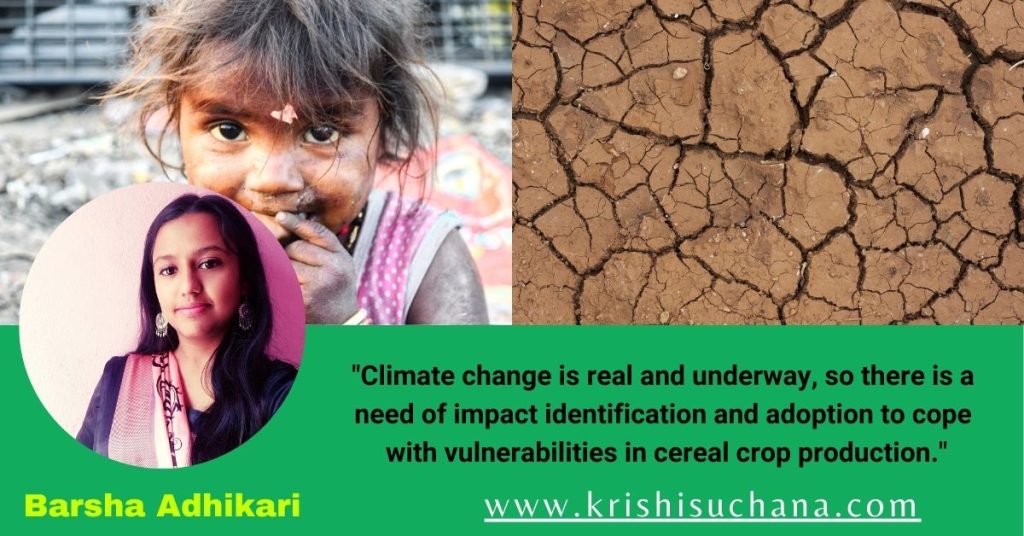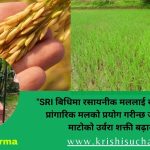Effect of Climate Change in Cereal Crops Production

INTRODUCTION
The agricultural sector plays a significant role for the path of national economic development. Agriculture exists worldwide and allows farmers to grow and improve their crops with available inputs (Banerjee and Adenaeuer, 2014). This sector plays a significant role and contributes to the economic prosperity of advanced countries, and its role in developing countries has its own role and importance. However, most crops are dependent on the prevailing climate in a specific region or area (Gornall et al., 2010). Weather and climate are key factors that influence agricultural productivity. Global climate change has become a serious threat to activities in the agriculture sector and has become critical for the sustainable development of any nation (Howden et al., 2007). Therefore, the main climate change impact is on the production of the agricultural sector because of the changes in temperatures, rain patterns, floods and famines, and it has negative effects on the land and water resources (Ali et al., 2017). Climate change is considered to be a global issue, but developing countries are more widely affected; the reason is their higher vulnerability to climate change and their lower ability to mitigate climate change effects (Ali et al., 2017; Rauf et al., 2018).
OVERVIEW
Cereal grains including wheat, maize, and paddy are considered primary crops as they are staple foods to most of the population across the globe. By 2050, a 70–100% increase in cereal food supply is required to feed the predicted world population of 9.8 billion people .Boosting the production rates is generally accepted as the solution to meet the increasing demand, but historic figures show that the current production rates are nowhere near what is required to meet the targets .Furthermore, this problem is further compounded with a drastic reduction in the amount of fertile and arable land available to grow these crops, which is expected to continue to decrease into the future due to current agricultural practices. Researchers agree that global climate change can have an impact on the production yields of crops and is an issue that must be addressed for attaining food security. Studies have shown that the earth will be warmer in the future, with the average surface temperature increasing at a pace of roughly 0.2 °C per decade over the next 30 years. Furthermore, estimates show that global temperatures will increase by 2.5 to 4.5 °C by the end of the 21st century as a result of the rising concentrations of greenhouse gases (GHGS; e.g., CO2 and CH4) in the atmosphere. Global warming can reduce the net carbon gain by increasing plant respiration rates, which in turn would decrease the production yield of crops and could even result in the invasion of weed, pathogens, and pests. For example, during the cultivation of wheat, an increase in temperature by 1 °C could reduce production yields by 3 to 10%. In a world where population size is soaring and reaching unsustainable levels, a drastic reduction in agricultural yields of major cereal crops can significantly hinder ensuring food security.
CLIMATE CHANGE IMPACT ON CROPS’ YIELD AND FOOD SECURITY
Paddy
Many studies showed that growing conditions (e.g., irrigation, temperature, fertilizer supply) play a vital role in the final yield of paddy. The study reported that the yields of paddy (Xiushui 134) under an alternate wetting and drying irrigation system were reduced significantly when compared to yields using continuous flooding irrigation. Matthews et al., simulated the impact of increased atmospheric carbon dioxide on the productivity of rice in various parts of Asia and found that on average the yields will go down by 4%.There are numerous studies that suggest that global warming will increase the yield of rice from 2.9–34% depending on highly optimistic scenarios primarily due to warming in the night and production moving to areas that have a cooler climate now that would heat up as a result of climate change in the 2050s and 2080s. However, these studies do not necessarily consider the socio-economic consequences in the regions that are currently growing rice and available strategies for these farmers to cope with the loss of rice production. Furthermore, despite a slight increase in production, various studies agree that in the long-run the yields will fall drastically as the global temperature increases by the end of the century. If no effective strategies to tackle reduced yields are implemented soon, global warming will cause a shortage of food, thereby resulting in food insecurity for future generations.
Millet
Millet crops have a deep-rooted system that is beneficial and can utilize the residual nitrogen, phosphorus, and potassium in the soil. Hence, this deep-root system does not require a high quantity of fertilizer in comparison with other crops. Compared to traditional cereal crops, pearl millet requires lower amounts of resources for its growth and can grow in adverse conditions (e.g., water and fertilizer shortage) due to its physiological characteristics. Moreover, millet is one of the most drought-resistant crops due to its strong root system, which allows them to grow in areas that experience frequent periods of dry weather. Many studies showed that the yield of millets in dry areas increased with the increasing temperature. Drought and heat tolerance together showed an increase in millet yield which amounts to 14% under climate change. Furthermore, millets also possess the ability to grow in hilly terrain and mountainous regions where cultivation of other cereals is difficult. This shows that millets possess the potential to be a vital crop that could grow with limited nitrogen input in drought, high-temperature and hilly regions around the world. This is one crop that clearly has the potential to reduce the carbon footprint as it has the least global warming potential, and at the same time is resistant to the global warming effects such as increased frequency in droughts and increased average temperatures.
Maize
Modeling of crop yields indicates that the maize yield will decrease by the century’s end because of climate change. Water supply is a vital factor for maize production. Studies revealed that from 1999 to 2002, the average yield of maize grown under irrigation (12.44 t ha−1) was 16.5% higher than when cultivated under non-irrigated condition (10.68 t ha−1). The yields of maize grown under two irrigation systems, raised bed and drip irrigation systems were compared. The results showed that compared to the drip irrigation system, the raised bed irrigation system was beneficial for increasing the plant height, biological yield, and grain yield by 1%, 5%, and 21%, respectively. Researchers have also evaluated the changes in the maize yields in Africa with a 2 °C raise in temperature and a 20% reduction in the precipitation. y reported that the yields reduced by about 10% under these conditions. Lobell et al., further used the historical data in understanding the role of moisture on the final yields of maize. They reported that a loss of 1% and 1.7% was observed in the final yield of maize for each day the crop spends at a temperature over 30 °C under rain-fed conditions and drought conditions. They showed that moisture plays a vital role in maize’s ability to cope with the high temperatures that will be caused due to global warming. The study concluded that if innovative management techniques are not implemented to control the increasing temperature, drastic yield loses in maize are possible in various parts of the world. Furthermore, these losses cannot be counteracted by the projected raise in yields due to the raise in atmospheric CO2 .
Wheat
Global climate changes and extreme weather events will have a huge impact on the production of wheat, one of the most widely consumed cereals. In China, researchers reported that wheat production rates would be reduced by 3 to 10% due to a 1 °C increase in temperature during the growing period based on the historical data of 1970–2000 A.D. The same study also reported that the increase in temperature over the last two decades would have resulted in the yields dropping by 4.5%, if not for the increased use of resources (like irrigation, fertilizers etc.,) in growing the crops.
Food Security
Food security is comprised of food availability, food accessibility, food utilization, and food systems stability. Climate change is a potential threat to food security as it is capable of decreasing crop yields, and intensifying competition over scarce resources. More and more countries are facing food insecurity as the climate is changing. It was predicted that by the end of 2017, Mongolia, Mauritania, Niger, Chad, Somalia, and Namibia would be facing a high level of food insecurity, which appears to have been true. According to the World Food Program, countries such as India, Zambia, Myanmar, Egypt, and Botswana will join the list of countries facing adverse food insecurity issues by the end of the 2050s. Furthermore, by the end of the 2080s, most of the African and Asian countries will be facing a high level of food insecurity due to increasing temperatures and depleting resources.
POSSIBLE STRATEGIES TO INCREASE CEREAL CROPS PRODUCTION
Climate change has the potential to influence the cereal yield directly by heat and water stresses but can also indirectly impact the fertilizer supply, diseases, and pests. Possible technical solutions for achieving improved crop yields and countering the effects of climate change are briefly discussed below.
Breeding
The average temperatures around the globe are estimated to increase by 2.5–4.5 °C by the end of this century. The maintenance of an appropriate temperature during the growth period is vital for cereal crops in different stages of cultivation since most of the cereal crops are highly sensitive to environmental and climatic variations. For example, high temperatures can reduce pollen viability and result in reduced kernel numbers and ultimately the yield during the heading and flowering periods.Traditionally, breeding is used to improve the yield of crops rather than their tolerance to high temperatures. However, there is an increasing need to breed new varieties of crops that can withstand extreme weather events and increasing annual temperatures with stable production rates. Studies have been carried out on exploiting and extending the existing genetic variability to develop new heat-tolerant and high-yielding crop genotypes. For example, new varieties of cowpeas have been developed that have higher average grain yields when grown under high temperatures.
Irrigation and Fertilizer Efficiency
Application of water and fertilizer plays a vital role in determining the yields of various crops during different stages of cultivation. The yield of crops increased only within a certain range of increase in water and fertilizer application. However, some developing countries (e.g., China, India, Algeria, Egypt, Iran, Mexico, and Pakistan) are facing issues with water scarcity due to climate change, population explosion, excessive agricultural activities, and industry usage. Thus using a drip irrigation system could effectively control water usage and help improve yields and reduce the quantity of water usage by more than 50%.
Furthermore, the use of fertilizer is another vital factor that directly impacts crop production. Over the past few decades, an estimated 30–60% increase in crop production was because of the use of fertilizers. However, long-term excessive application of fertilizers has been shown to have a negative effect on the soil and on the quality of cereal crop. Several studies have shown that over-fertilization can lead to soil acidification. Furthermore, nitrogen leaching and ammonia volatilization also contribute to environmental issues in areas where urea and nitrogen-fertilizers are applied. Similarly, a study reported that the soil pH declined to 4.3 after 13-years of production in Shouguang and Shandong provinces in China, which potentially can lead to reduced crop yields and quality. Therefore, an emphasis has to be placed on using fertilizers at appropriate levels, which can save resources and avoid environmental pollution.
Increasing the Cultivation Area of Tolerant Cereal Crops
The aforementioned millets, and especially pearl millet, are considered to be the most drought-tolerant among the major cereal grain crops (e.g., wheat, maize, and paddy). As studies have shown, the cultivation of rice will move to the regions that are warming-up (traditionally temperate zones) as global temperatures increase in Asian countries like China, and India. To compensate for the loss of the rice crop, Millets could be grown in the resulting dry lands as a result of their strong root system, which helps them to tolerate water stresses. Moreover, millets need little to no fertilizers. Millet is a C4 crop, meaning it has the ability to fix carbon at a lower transpiration rate compared to other cereal crops. Millets can adapt to various soil environments (sandy, acidic and alkaline soils, and acidic soils) with a wide range of soil pH between 4.5 to 8.0.Apart from the ability to fix carbon, research has showed that the C4 crops (including maize) have various other advantages. Firstly, reports have shown that the projected rate of yield decline in C4 crops is much smaller compared to C3 crops like rice and wheat. This is primarily due to their tolerance towards low moisture atmosphere. The water use efficiency is 150–400% higher in C4 crops compared to C3 crops. Secondly, C4 crops have a lower photo-respiration under increased CO2 and temperature in the atmosphere, which are predicted to be the result of global warming. Some modeling studies have suggested that by using improved and water-efficient irrigation technologies in the future, the yields of C4 crops can be increased by up to 38% under the predicted climatic conditions in few areas, whereas the yields of C3 crops will have no significant change. Though there are various C4 crops, millets are more environment-friendly because they release less greenhouse gases when compared to other cereal crops and climate change effects appear to have less influence on millet yields. Sorghum is another drought-tolerant crop, which is mostly attributed to its dense and prolific root system, ability to maintain relatively high levels of stomatal conductance, maintenance of internal tissue water potential through osmotic adjustment, and phenological plasticity. Sorghum is another drought-tolerant crop, which is mostly attributed to its dense and prolific root system, ability to maintain relatively high levels of stomatal conductance, maintenance of internal tissue water potential through osmotic adjustment, and phenological plasticity. Thus, increasing the area of land used to grow tolerant cereal crops (e.g., millet and sorghum) is a vital strategy for reducing the influence of climate change, issues of water shortage, and food security.
CONCLUSION
Climate change is real and underway, so there is a need of impact identification and adoption to cope with vulnerabilities in cereal crop production. Climate change and especially the increase in ambient temperatures will reduce the yields of major cereal crops. Hence, to achieve our goals of food security, we need to emphasize the use and production of food crops that can withstand the on-going changes to the climate to replace or be an alternative to the current major cereal crops, especially in the arid and semi-arid regions around the globe that are at a greater risk of food insecurity. Researchers and growers should develop diversification strategies based on local conditions. This should be part of the strategy for achieving food security within the context of climate change and a rapidly increasing population. Furthermore, it has to be noted that a holistic approach is required in tackling food insecurity issue as there is no single solution that can solve the issue.
Writer: Barsha Adhikari (Student, Bsc. Ag IAAS Paklihawa Campus)

 एउटा यस्तो विषालु भ्यागुता, जसको मुल्य नै पर्छ ३ लाख, जान्नुहाेस्
एउटा यस्तो विषालु भ्यागुता, जसको मुल्य नै पर्छ ३ लाख, जान्नुहाेस्  भोलि र पर्सि बालबालिकालाई भिटामिन ए खुवाइदै
भोलि र पर्सि बालबालिकालाई भिटामिन ए खुवाइदै  खगराज अधिकारी गण्डकीको मुख्यमन्त्री नियुक्त
खगराज अधिकारी गण्डकीको मुख्यमन्त्री नियुक्त  सुनसरीमा दुवै पक्षबीच सहमति, कर्फ्यु खुकुलो हुदै
सुनसरीमा दुवै पक्षबीच सहमति, कर्फ्यु खुकुलो हुदै  स्टेफेनको शतकमा आयरल्याण्ड वोल्भ्सले नेपाल ए लाई दियो २८५ रनको लक्ष्य
स्टेफेनको शतकमा आयरल्याण्ड वोल्भ्सले नेपाल ए लाई दियो २८५ रनको लक्ष्य 


